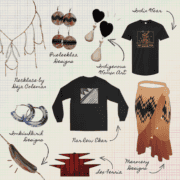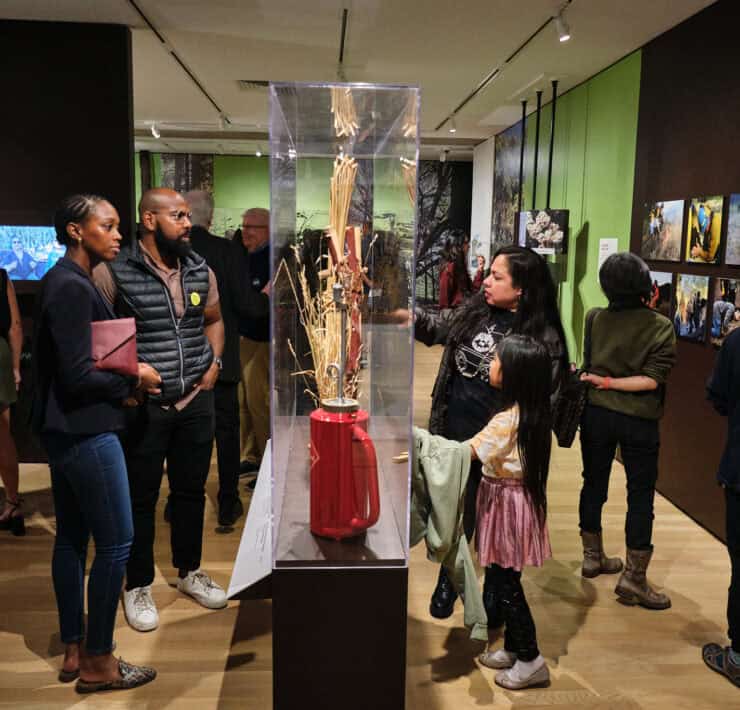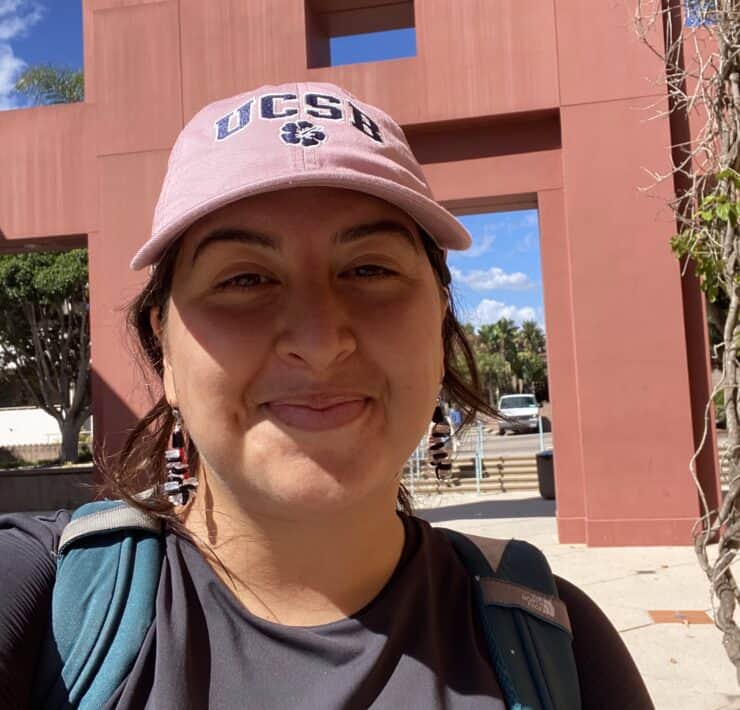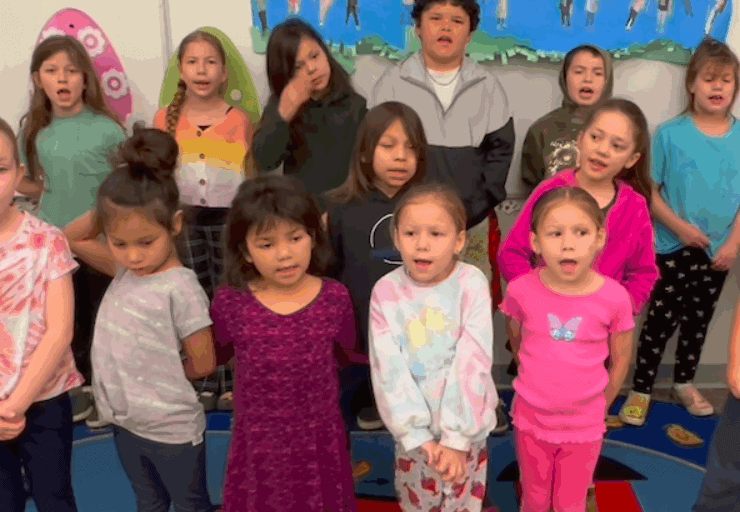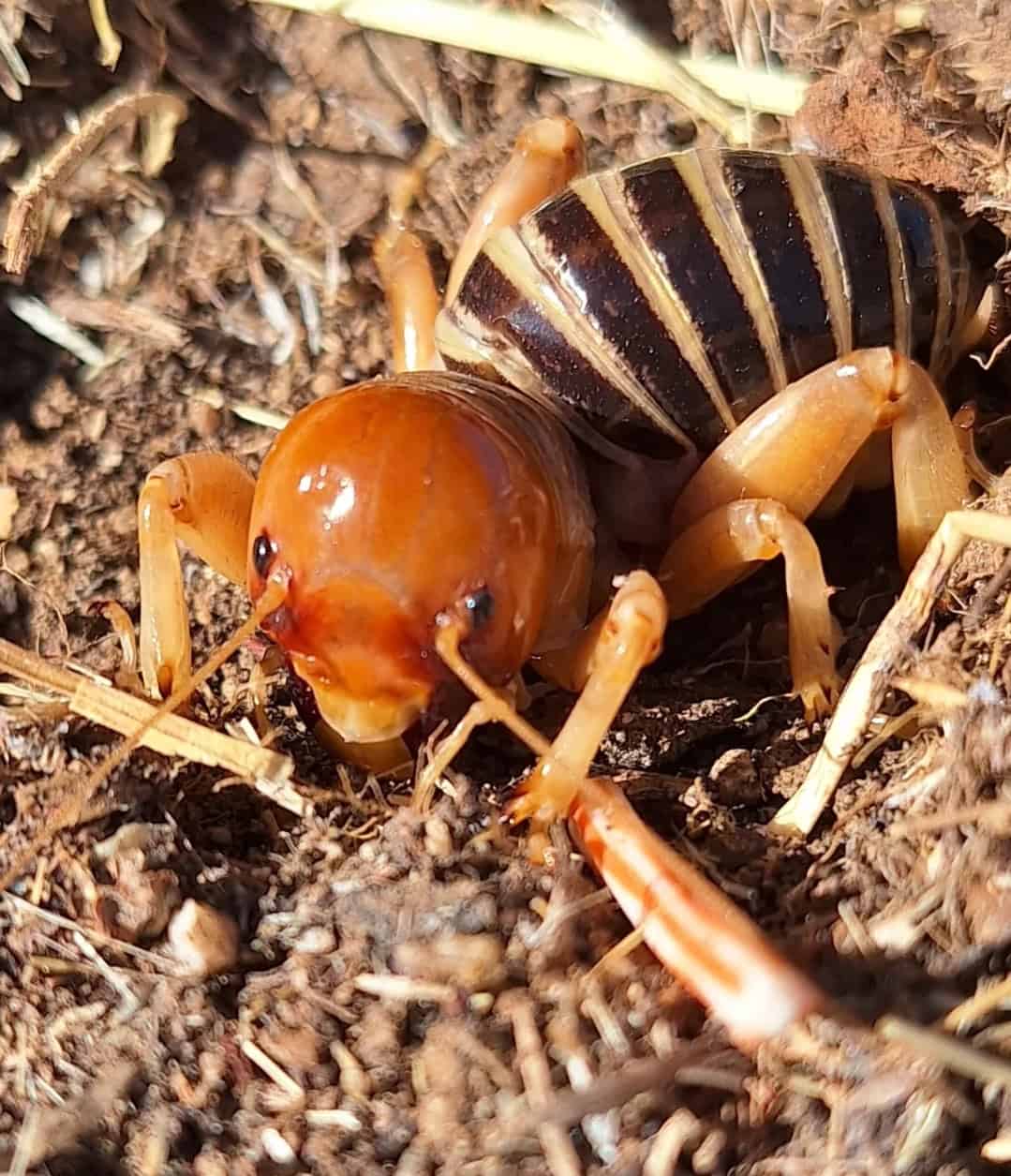
By Muriel Ammon
Nilts’it, then thwack. “I turned around, to see who’d smacked me in the back of my head… but no one was there,” recounted Yurok Flower Dancer Rachel Sundberg. “I was just minding my own business.” Sundberg had laid out basket caps and necklaces of pine nuts, abalone, and dentalium. This regalia would be joining the dancers that night, into the xontah for the xoq’it-ch’iswa:l. Everything was set up exactly how she liked it, a system she’d perfected over the past decade of Flower Dance resurgence for Hupa, Yurok, and Karuk people. Here she was at Łe:lding, the Tsnungwe village ‘where the rivers flow together,’ continuing this uplifting ceremony making luck for young women. Turning her attention back to the near injury, she looked down and saw a little red being on the ground, regathering its composure. She had been hit in the back of the head by a potato bug.
Tse:-k’iłje:n, ‘bald head’ in Hupa. Larger than your average bug, the ‘Jerusalum cricket’ or ‘potato bug,’ as it is colloquially referred to, is distinguished by its probing antennae, striped abdomen, and bald, shiny head. Rarely seen, it lives below ground. This bug must have been curious about the ceremony that was taking place and popped up to take a peek. It’s probably a good sign of biodiversity to see a potato bug. These sightings can serve as a signal from the land, hopefully that you’re doing something right. These signals are sometimes hard to read. Seeing a potato bug is a lot different than one dropping in on you.
Where did this potato bug come from? I think it had something to do with the place we chose to build this dance. This was the first Tsnungwe Flower Dance held in some decades. Hay xoq’it-ch’iswa:l xwa k’inałdung Xosa:k’. It was held for me. My family, friends, and community at large, contributed their knowledge and experience, trailmaking and housebuilding, dancing and regalia, and love and support to bring this ceremony back to Łe:lding. The functional spaces of the dance needed to be mapped out. The first step was to build the xontah, our traditional house. We chose the grassy field above the river that, once you dig a few inches, reveals an expanse of sand. It’s always been sandy there. That’s where they used to hold stick games, back in the day. These bugs live and move underground. They’re primarily found inches below wood piles. It seems like a xontah and a sandy bank covered in grass would give them ideal habitat and easy travel routes. They’ve probably always been living there. Life exists in so many forms throughout Łe:lding, any development will disturb someone’s habitat. Perhaps this was a welcome addition to their home. My cousins built the xontah, with their construction equipment and donated old-growth redwood and cedar boards. My uncle, just beginning to get into woodwork as an artistic medium, carved the steps. From the dance floor, our two mountains face east. Tse:ning-ding, which we Tse:ning-xwe are named for, also called Ironside Mountain, and Ninis’a:n Łiqay, Mount Shasta, shared by the tribes here as a significant and powerful land being. It’s a special building, in a special place. And now it’s the central ceremonial space for our people.
Sitting atop potato bug-ville, Rachel came and got smacked by that tse:-k’iłje:n. Likely, the building and digging of the past months, and the cars driving down that night, notified the bugs that something was up. Potato bugs respond to drumming. They don’t rub their legs like crickets, because they’re not actually crickets. Perhaps the bug was drawn to the vibrations of the people’s singing and tapping along with sticks. Whatever the reason, it made its way to the surface. That alone is not a surprise. They do that sometimes. What I cannot understand is how it fell down on her with such force. These bugs don’t fly. They don’t even jump. There weren’t any trees for it to fall out of. This means something, likely a bird, was carrying off the ‘cricket’ and dropped it on her. That’s an even more unlikely story, but it’s my only explanation.
She didn’t tell me about this, until years later, when it happened again. Another Flower Dance at Łe:lding, and Rachel came down with her caps and beads. She set up the women’s camp just so, handing out the regalia to dance. “UGGE!!!” Well, if she was Hupa she might have said it like that. I don’t know how to say ‘ouch’ in Yurok. She reached for the back of her head, this time suspiciously looking towards the ground. Sure enough, another potato bug lay behind her on the ground. Tse:-k’iłje:n nilts’it. A potato bug fell. “There’s just something about this place!” she laughed. But why was this happening? And what could it mean?
As it turns out, although this is in no way an explanation, Łe:lding is known for its potato bugs. In our oral histories lies a story of the first deaths in the world, which relates to the passing of the k’ixinay, the spiritual beings that lived here before humans came. Not five sentences into the story, you find, “Haya:ł-’ung’ tse:-k’iłje:n mitł’owe’ na:’ischwe’n. And [the potato bug] made its medicine,” located in Łe:lding. There’s so much that’s recorded that I wish I could know more about. We just have these scraps, at times, that aren’t clear. And yet, I feel a relationship to the potato bugs. We are from Łe:lding, them and me. It’s clear these bugs have been living here a long time. Just as we have. They go about their business. We hold Flower Dances. For me, it’s an affirmation of the continuity of our way of life, of our traditional ceremonies, of our bodied experiences on the land.
Maybe Rachel just has really good luck. ‘Nilts’it’, after all, means ‘it falls hither’ and translates more broadly to ‘it comes to someone as a gift or a blessing; it befalls someone.’ I think it’s more to do with her dedication to the community. Rachel has put on and supported so many ceremonies, worked with and made regalia, studied language, leaned into her songs (she has an amazing voice), and put so much energy into uplifting our community. She is a positive and powerful force. While there’s more to understand about the exact medicine of tse:-k’iłje:n, it definitely found the right person. Maybe it needed some of her medicine.
It is a gift that families choose to have Flower Dances for their daughters, and that Tsnungwe girls can come of age in the village their ancestors lived and danced in. There is a growing community of people who prioritize and celebrate young women, in their strength, in their potential, in their unique identities. It is a blessing to be a part of Indigenous feminist resurgence through ceremony. If the potato bug signifies continuity, that is clear in the function of the field. Rather than becoming a stick games field, this place is again a community gathering space, used in the form that is most needed at this time. Four young women have since ‘graduated’ from this ceremony as k’inałdung. Perhaps the potato bug signifies a type of medicine. My own dance provided me with challenges, as well as a larger support circle, acknowledgement of my own inner strength, and an introduction to the ceremonial community. The other dances gave me a purpose, to take on responsibilities within the Flower Dance in service of others. That’s the good luck that came from the Flower Dance to me. And then there’s the unnamed medicine, what can be felt, what may surprise. An energy that flows through Łe:lding, because of the dances returning and the people who pray. Until I find an answer, I’ll wait for the potato bug to fall out of the sky and hit me on the back of the head.


